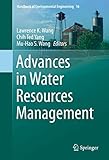Advances in water resources management / Lawrence K. Wang, Chih Ted Yang, Mu-Hao S. Wang, editors.
Material type: TextSeries: Handbook of environmental engineering (2004) ; v. 16.Publisher: Cham : Springer, [2016]Copyright date: ℗♭2016Description: xii, 569 pages : illustrations (some color)Content type:
TextSeries: Handbook of environmental engineering (2004) ; v. 16.Publisher: Cham : Springer, [2016]Copyright date: ℗♭2016Description: xii, 569 pages : illustrations (some color)Content type: - text
- computer
- online resource
- 3319229230
- 9783319229232
- TD170 .H37 2004 v. 16
| Item type | Current library | Call number | Status | Date due | Barcode | |
|---|---|---|---|---|---|---|
| E-Resources | Main Library E-Resources | 363.61 Ad244 (Browse shelf(Opens below)) | Available | E001689 |
Browsing Main Library shelves, Shelving location: E-Resources Close shelf browser (Hides shelf browser)
Includes bibliographical references and index
1. Multi-Reservoir System Operation Theory and Practice -- 2. Management of Aquifer Systems Connected to Streams Using Semi-Analytical Models -- 3. One-Dimensional Model of Water Quality and Aquatic Ecosystem/Ecotoxicology in River Systems -- 4. Hydraulic Fracturing and Shale Gas: Environmental and Health Impacts -- 5. Bioaugmentation for Water Resources Protection -- 6. Wastewater Renovation by Flotation for Water Pollution Control -- 7. Determination of Reaeration Coefficient of Saline Receiving Water for Water Quality Management -- 8. Sensitivity Analysis for Stream Water Quality Management -- 9. River Ice Process -- 10. Computer-Aided Mathematical Modeling of Water Properties.
This volume provides in-depth coverage of such topics as multi-reservoir system operation theory and practice, management of aquifer systems connected to streams using semi-analytical models, one-dimensional model of water quality and aquatic ecosystem-ecotoxicology in river systems, environmental and health impacts of hydraulic fracturing and shale gas, bioaugmentation for water resources protection, wastewater renovation by flotation for water pollution control, determination of receiving water?s reaeration coefficient in the presence of salinity for water quality management, sensitivity analysis for stream water quality management, river ice process, and computer-aided mathematical modeling of water properties. This critical volume will serve as a valuable reference work for advanced undergraduate and graduate students, designers of water resources systems, and scientists and researchers. The goals of the Handbook of Environmental Engineering series are: (1) to cover entire environmental fields, including air and noise pollution control, solid waste processing and resource recovery, physicochemical treatment processes, biological treatment processes, biotechnology, biosolids management, flotation technology, membrane technology, desalination technology, water resources, natural control processes, radioactive waste disposal, hazardous waste management, and thermal pollution control; and (2) to employ a multimedia approach to environmental conservation and protection since air, water, soil and energy are all interrelated.
There are no comments on this title.








